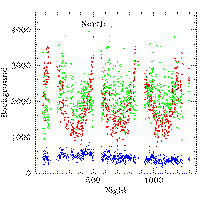
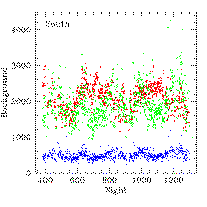
This page is frequently revised, so the reader is strongly encouraged to consult the online version of the Explanatory Supplement for updates. The figures below are based upon the calibrator scans from the full production processing. All dates are given by Survey Night Number. The following table may help translate Night Number to calendar dates.
| Night Number | Date | Notes |
|---|---|---|
| 100 | 1997 June 8 | |
| 154 | 1997 August 1 | Monsoon Start |
| 187 | 1997 August 31 | Monsoon End |
| 250 | 1997 November 5 | |
| 300 | 1997 December 25 | |
| 384 | 1998 March 19 | CTIO Start |
| 450 | 1998 May 24 | |
| 507 | 1998 July 20 | Monsoon Start |
| 565 | 1998 September 16 | Monsoon End |
| 602 | 1998 October 23 | Leach Electronics at Hopkins | 700 | 1999 January 29 | 729 | 1999 February 27 | Leach Electronics at CTIO |
| 872 | 1999 July 20 | Monsoon Start |
| 927 | 1999 September 13 | Monsoon End |
| 1037 | 2000 January 1 | Y2K |
| 1244 | 2000 July 26 | Monsoon Start |
| 1293 | 2000 September 13 | Monsoon End |
Nightly Averages
Average Backgrounds: The backgrounds, shown in Figures 1 and 2, are such that the Ks background, presumably dominated by the thermal contribution, is highest in the summer -- as a result, the airglow-dominated H background was worse than Ks in the winter. Starting with 1999 September, H background data have been multiplied by 1.3 to (roughly) account for the decreased sensitivity of the new array.

|

|
| Figure 1 | Figure 2 |
Average FWHM: As shown in Figures 3 and 4, our best images in the north are about 2.7´´-2.8´´ FWHM. The southern seeing values are better. It appears that the telescope adjustments in early 1998 September improved the image quality in the north, but over time these improvements were lost. The 1999 September adjustments resulted in better images than ever seen before in the north. The better images have been sustained through the winter and summer of 2000.
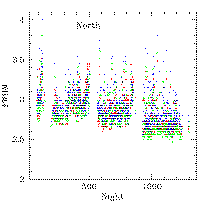
|
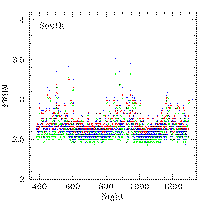
|
| Figure 3 | Figure 4 |
Average Limiting Magnitude: The signal-to-noise ratio (S/N) for faint stars depends upon both the background and the "seeing". The Level 1 specifications for 2MASS limiting magnitudes at S/N=10 are 14.3 mag at Ks, 15.1 mag at H, and 15.8 mag at J. The actual limiting magnitudes are shown in Figures 5 and 6. Since the calibrator fields are observed six times consecutively, the observed scatter gives a measure of the S/N. R. Cutri has found that the limiting magnitude can be parameterized in terms of the backgrounds and seeing, and this parameterization is one of the factors used to grade the quality of science scans. The figures below are based upon the parameterization, transformed into the magnitude at which S/N=10 is achieved. We have rederived new relations for the southern camera and the new northern H array, and these relations are now used in these figures.
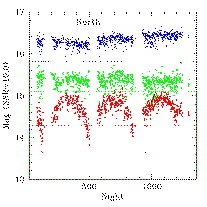
|
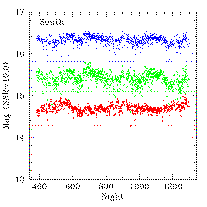
|
| Figure 5 | Figure 6 |
Average 2nd Image Moment Ratio: Figures 7 and 8 have been updated to use the new elongation statistic, for which elongation appears as values<1.0. For some nights, only the old "Second Image Moment ratio" was available. In this case, we plot any values >1.0 as 1/old_statistic. This will underestimate the elongation, as is obvious in the southern plots (nights 520-580) where the elongation is along position angle 45°. Note the bad data from the northern summers, particularly 1997. At high temperatures, J,H and Ks cannot be focused at the same time, resulting in worse Ks second image moment ratios in September and June.
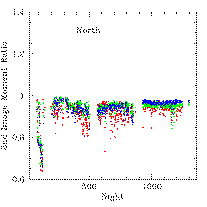
|
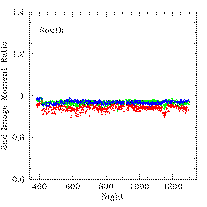
|
| Figure 7 | Figure 8 |
Zero-Points: The zero-point, shown in Figures 9 and 10, measures the relationship between flux and camera counts (DN). More positive zero-points are more sensitive, in the sense that there are more counts for a given flux. The J zero-point varies more strongly than H or Ks. This is no surprise, as the J zero-point often varies during the course of a night. The huge jump at CTIO night 729 can be attributed to the change in electronics, since the gain was expected to change. Also, the mirror was cleaned at that point, which may also have helped. The jump at CTIO night 685 is due to the camera window being cleaned. The recent zero-point improvements at night 1124 (000325n) and 1129 (000402s) coincide with mirror cleanings. Note that CTIO has just returned to normal zero-points.
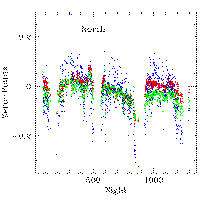
|
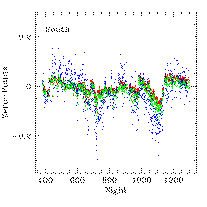
|
| Figure 9 | Figure 10 |
[Last updated 2000 Sep 20 by J. Gizis. Modified 2000 Sep 21 by S. Van Dyk.]